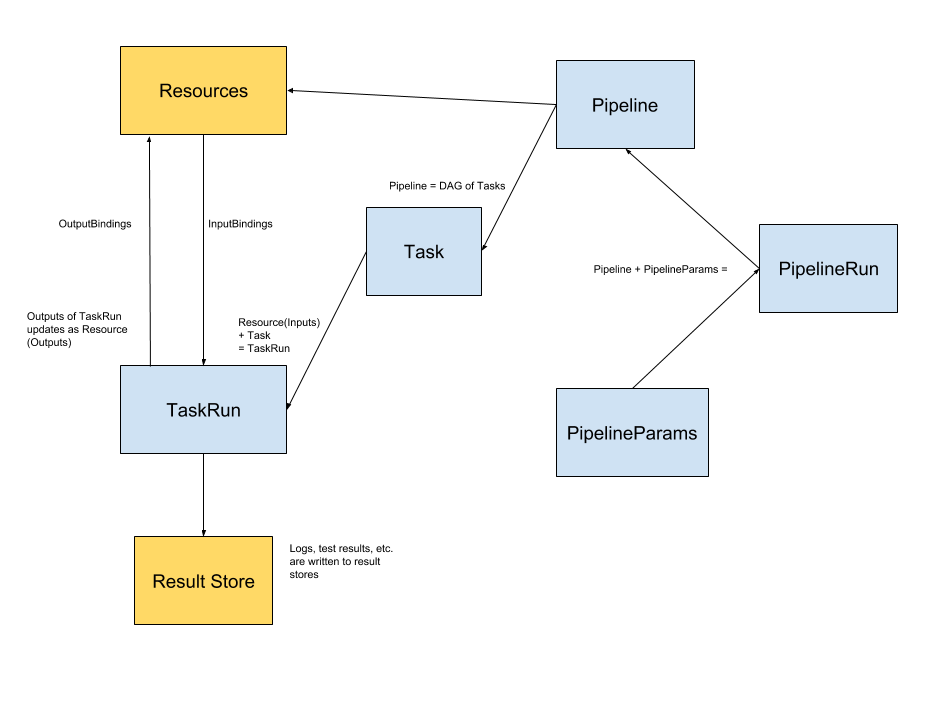This repo contains the API definition of the Pipeline CRD and an on cluster implementation of that API. The goal of the Pipeline CRD is to provide k8s-style resources that allow the declaration of CI/CD-style pipelines, which can be backed by any arbitrary implementation.
Features the Pipeline CRD will support include:
- Conditional, parallel and distributed execution
- Interaction with CI/CD resources such as source code, artifacts, resutls, deployments and clusters
The goal of the Pipeline CRD is to fit into and cooperate with the Knative ecosystem, specifically:
See examples for some examples of how this is intended to work.
The CRDs involved are:
High level details of this design:
- Pipelines do not know what will trigger them, they can be triggered by events or by manually creating PipelineRuns
- Tasks can exist and be invoked completely independently of pipelines; they are highly cohesive and loosely coupled
- Test results are a first class concept, being able to navigate test results easily is powerful (e.g. see failures easily, dig into logs, e.g. like the Jenkins test analyzer plugin)
- Tasks can depend on artifacts, output and parameters created by other tasks.
- Resources are the artifacts used as inputs and outputs of TaskRuns.
Task is a CRD that knows how to instantiate a Knative Build,
either from a series of steps (i.e. Builders)
or from a BuildTemplate.
It takes Knative Build and adds inputs and outputs. Where these inputs and outputs are provided
from is not known to a task, so they can be provided by a Pipeline or by a user invoking a Task directly.
Tasks are basically Knative BuildTemplates
with additional input types and clearly defined outputs.
Pipeline describes a graph of Tasks to execute. It defines the DAG
and expresses how all inputs (including PipelineParams and outputs
from previous Tasks) feed into each Task.
Dependencies between parameters or inputs/outputs are expressed as references to k8s objects.
PipelineParams contains parameters for a Pipeline. One Pipeline
can be invoked with many different instances of PipelineParams, which can allow
for scenarios such as running against PRs and against a user’s personal setup.
PipelineParams can control:
- Which serviceAccount to use (provided to all tasks)
- Where results are stored (e.g. in GCS)
Creating a TaskRun will invoke a Task, running all of the steps until completion
or failure. Creating a TaskRun will require satisfying all of the input requirements of the
Task.
TaskRuns are basically Knative Builds with inputs and
outputs, and in the future we may want to transition Builds to become Tasks.
TaskRuns can be created directly by a user or by a PipelineRun.
Once a TaskRun has been created, it will start excuting its steps
sequentially. The conditions field will be updated as the TaskRun
executes:
- The
Startedcondition will be added when the first step starts. - The
Completedcondition will be added when the last step completes, or after a non-zero exit code from a step. - The
Successfulcondition will be added after theCompletedcondition and will indicate if the run succeeded or failed.
When the TaskRun has completed, the steps field will indicate
the exit code of all steps that completed.
Creating a PipelineRun executes the pipeline, creating TaskRuns for each task
in the pipeline.
PipelineRuns tie together a Pipeline and a PipelineParam.
A PipelineRun could be created:
- By a user manually
- In response to an event (e.g. in response to a Github event, possibly processed via Knative eventing)
Once a PipelineRun has been created, it will start excuting the DAG
of its Tasks by creating a TaskRun for each of them. The
conditions field will be updated as the PipelineRun
executes:
- The
Startedcondition will be added when the firstTaskRunis created. - The
Completedcondition will be added when the lastTaskRuncompletes (or fails). - The
Successfulcondition will be added after theCompletedcondition and will indicate if thePipelineRunsucceeded or failed.
When the PipelineRun has completed, the taskRuns field will contain
references to all TaskRuns which were executed and their next and
previous TaskRuns.
Resources in a pipelines are the set of objects that are going to be used
as inputs and outputs of a TaskRun.
Resourcesis created directly in a pipeline configuration and bound toTaskRunas an input and/or output source.- The (optional)
passedConstraintkey on aninput sourcedefines a set of previous task names. - When the
passedConstraintkey is specified on an input source, only the version of the resource that passed through the defined list of tasks is used. - The
passedConstraintallows forTasksto fan in and fan out, and ordering can be expressed explicitly using this key since a task needing a resource from a another task would have to run after.
